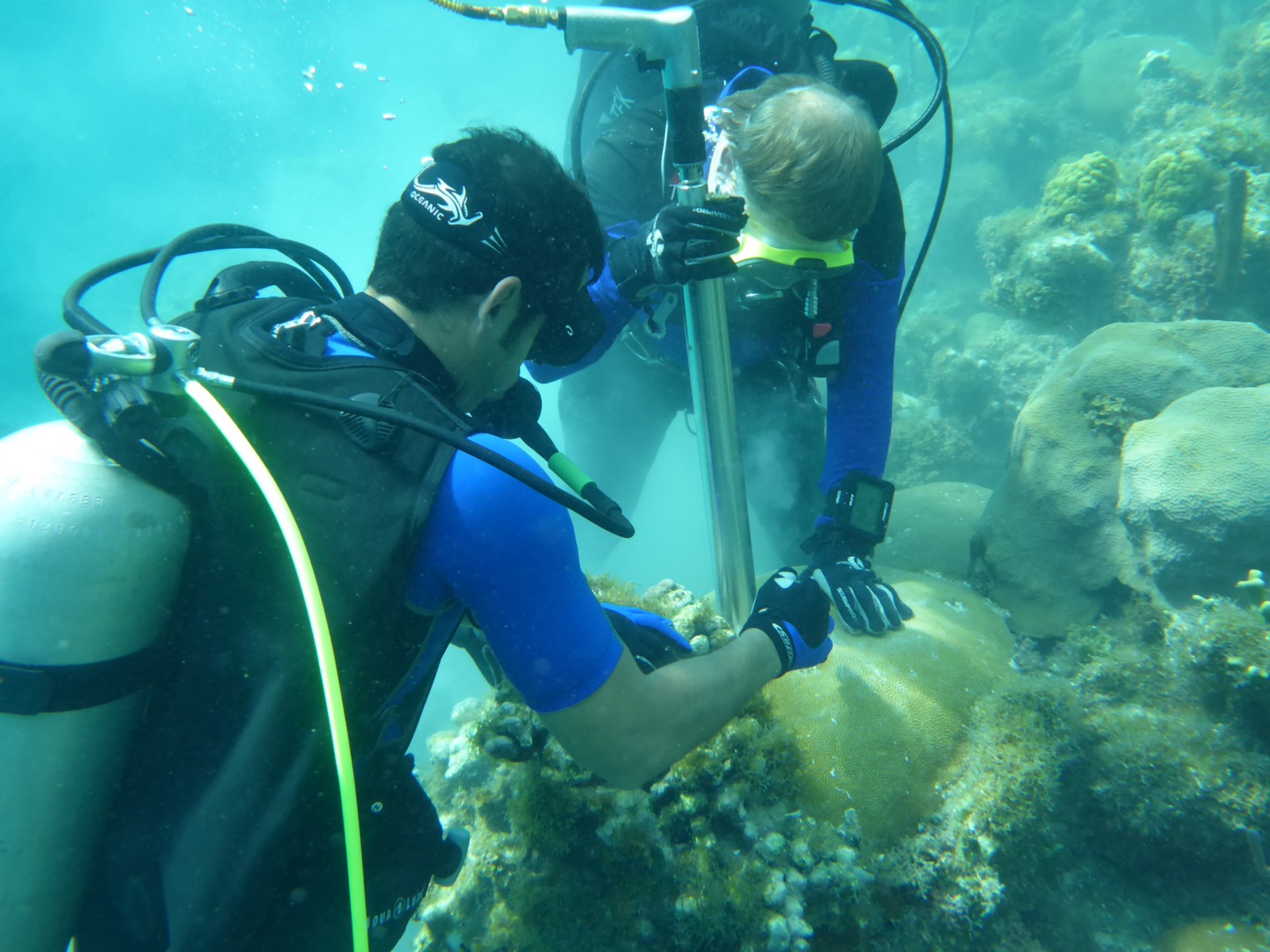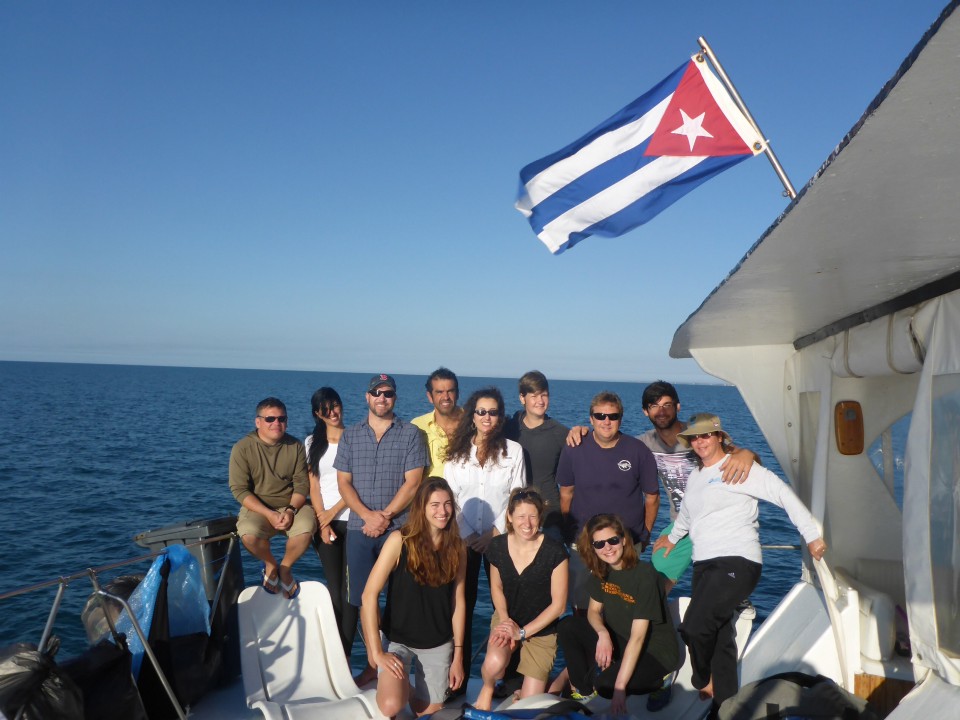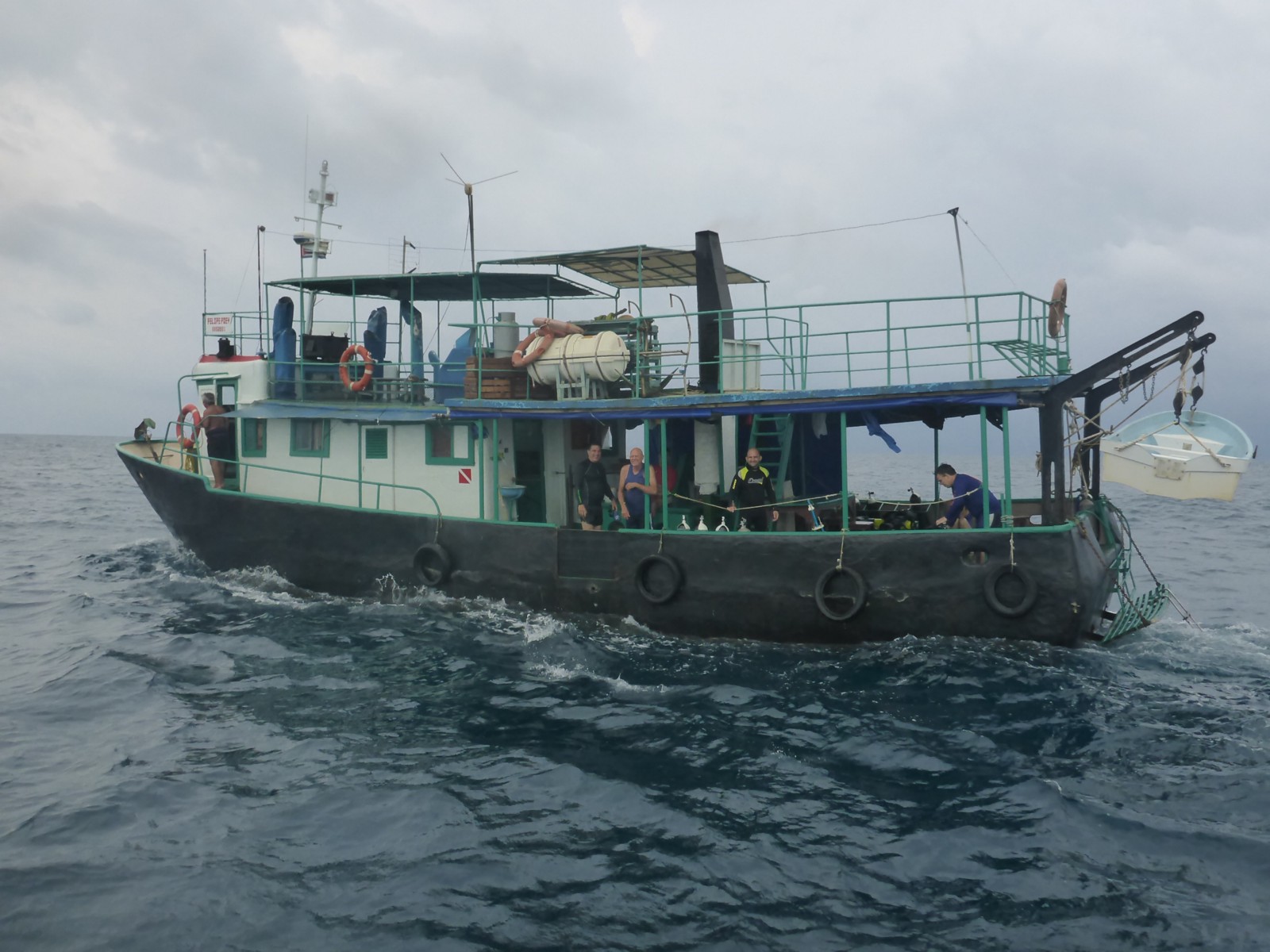For years, it was an open secret among divers and researchers that the coral reefs of Cuba were spectacular. The few who found a way to dive off the coast of the island came back with tales of the sea grass beds of the Gulf of Batabanó, of shipwrecks and caves along the Isla de la Juventud (Isle of Youth), and of the lush reefs and mangrove forests of the Jardines de la Reina (Gardens of the Queen) archipelago.
Cuba is ringed by four major coral reef chains; taken together, they’re over twice as long as the Mesoamerican Reef. Decades of low tourism and limited development took a toll on the Cuban economy, but they also helped the major chains to escape much of the pollution and destruction that had been wrought elsewhere in the Caribbean. In many of Cuba’s verdant gulfs and archipelagoes, the corals quietly thrived.
Today, the improving relationship between the United States and Cuba means that more collaboration is possible on scientific topics than ever before. That means that researchers and conservationists are now scrambling to collect data on Cuban coral reefs — before climate change or increased tourism destroy their preserved state.
“Corals are fantastic archives of climate and environmental records. They sit still, they don’t move around, they don’t go up and down in the water column.”
Fernando Bretos, the director of the Cuba Marine Research and Conservation Program (also known as CubaMar) is one such conservationist. In his role with CubaMar, his focus is on building relationships between researchers in the U.S. and Cuba. Since 2007, he has also organized the Trinational Initiative, an annual workshop where representatives from Cuba, Mexico, and the U.S. meet to discuss marine science issues.
Bretos first visited Cuba in 1999. At that time, he had recently taken a position focusing on the Caribbean at the Ocean Conservancy. “I was selected because I spoke Spanish and knew Latin America,” he says, “The position involved considerable work in Cuba, and at the time, there were very few U.S. organizations doing any work on the island.”
The Cuba that Bretos encountered in 1999 was, in some ways, primed for conservation partnerships. Throughout the 1990s, the Cuban government had made environmental protection an area of increasing political focus. At the 1992 Earth Summit in Rio de Janeiro, Fidel Castro gave an impassioned speech on the importance of conserving natural resources. And five years later, in 1997, Cuba passed a sweeping environmental law framework that gave new authority to its environmental protection agency, created strict standards for coastal development, and gave the government more ability to create and control activities within protected areas (though enforcement of these laws has been patchy in some areas).
Throughout the 2000s, Bretos traveled to Cuba regularly, building partnerships with researchers at the Centro de Investigaciones Marinas (Center for Marine Research) — a marine research institute at the University of Havana — and working on conservation projects, such as a successful attempt to reduce sea turtle poaching at Guanahacabibes National Park.

(Photo: CubaMar)
His efforts in Cuba culminated in the Three Gulfs Project, an ambitious attempt to study the coral reefs. The project was born out of conversations between Bretos and Patricia Gonzalez, the director of the CIM, who wanted a focused effort to study the health of Cuba’s largest gulfs. Eventually, the project became a three-way collaboration between CubaMar, the CIM, and the Woods Hole Oceanographic Institute.
The project has a few main research goals. The first is simply to determine the overall health of the reefs by conducting Rapid Ecological Assessments, or REAs.
The team hopes that the REAs will shed light on why Cuban coral reefs are healthier than reefs elsewhere in the Caribbean. One of the Three Gulfs Project’s working hypotheses of the research team is that the preservation of Cuba’s coral reefs is partly due to the abrupt collapse of the Soviet Union in 1991. Prior to that time, the USSR had heavily subsidized sugar production in Cuba, but, after its collapse, agricultural policies on the island shifted radically. In particular, the use of synthetic fertilizer dropped dramatically. In other parts of the world, fertilizer runoff has been a major contributor to coral reef decline.
Today, the improving relationship between the United States and Cuba means that more collaboration is possible on scientific topics than ever before.
“We’re 50 years late in gathering this data,” says Daria Siciliano, the lead scientist for CubaMar. “For decades, Cuba was a black hole. It’s the largest island in the Caribbean, and there’s almost no data on things like fish distribution.”
To conduct the REAs, at each of the three or four dive spots they visit in a day, the researchers divide up into groups — a fish team, a coral team, an algae team. Each team picks specific areas to quickly count and evaluate the marine life at the dive site.
One member of the coral team, for example, will catalog the overall health of the corals. They’ll look for evidence of microbial diseases that affect corals and for symptoms of bleaching, a condition that occurs when the water in coral reefs becomes too warm and the corals expel the microscopic algae that live within their structures.
The second research focus is on the microbial health of the reef system. That’s the specialty of Amy Apprill, a coral reef microbiologist from the Woods Hole Oceanographic Institute (WHOI). This is a recent field of study: According to Apprill, it’s only over the last 10 years or so that researchers have developed the tools to analyze coral reef microbiomes, which might be able to indicate the overall health of the reef system.
“It used to be assumed that these organisms were all parasitic and had negative effects on the coral, but now it’s known that it’s a much more sophisticated relationship,” Apprill says. “We’ve been studying these issues in the Florida Keys and wanted to contrast it with a similar coral environment.”

(Photo: CubaMar)
At each dive site, Apprill drops a small probe into the water that measures the salinity, temperature, and pH of the reef. The team also takes water samples from different depths and small coral samples from different species. Apprill returned to the U.S. with over 1,000 samples, which will go toward building a picture of what the microbiome looks like in a healthy Cuban reef.
The last focus is looking for large, dense coral colonies from which to take core samples. It turns out that corals store a lot of information about what the ocean environment has been like throughout their lifetime.
“Corals are fantastic archives of climate and environmental records,” says Konrad Hughen, a marine chemist at the WHOI. “They sit still, they don’t move around, they don’t go up and down in the water column.”
As a coral grows, it incorporates trace elements from the surrounding seawater into its structure. The ratio of those elements can show what the ocean environment was like at that moment. Hughen’s lab, for example, is looking at the ratio of strontium to calcium within the coral structures. When ocean temperatures are high, the coral absorbs less strontium relative to calcium; when temperatures dip, the corals do the opposite.
“For decades, Cuba was a black hole. It’s the largest island in the Caribbean, and there’s almost no data on things like fish distribution.”
But it can be challenging to find a suitable colony from which to extract a core. Many coral species, especially in the Caribbean, have structures that aren’t dense enough to get fine-grain data from. Beyond that, the coral also has to survive disease, bleaching events, hurricanes, and other dangers to build up a long data history.
That’s why it was so exciting when, on the cruise in February 2015, the researchers came across a massive coral in a protected shelf near the Jardines de la Reina reef. The coral was a species called Siderastrea — not exactly the species they were hoping to find, but fine-grained enough to be useful. And the coral was huge: a meter and a half deep and three meters wide.
The extracted core is nearly five feet long and contains data going back nearly 230 years. It’s a tremendous archive of data in a region where these records are rare; Hughen says there have only been four other usable cores taken from the Caribbean so far. From the core, the researchers will be able to build a month-by-month picture of the ocean environment around Cuba since the late 1700s.
Once the core was safely back in the U.S., it was split in two. One half of the core went with Siciliano to her lab at the University of California-Santa Cruz, where she will study what the ratios of certain oxygen isotopes can reveal about nutrient-loading in the reef over time.*
The other half went to Hughen’s lab at WHOI, where his team is using the strontium-calcium method to build a similar data set. Hughen says that the data set will eventually be used to inform climate models and will be useful in determining whether temperature fluctuations are due to natural variations or man-made global warming.
While the Three Gulfs Projects has had three successful cruises so far, that doesn’t mean that the partnership has been an easy one. Bureaucratic and political challenges have dogged the researchers on both sides of the Florida Straits.

(Photo: CubaMar)
From the American side, the embargo puts serious strain on the logistics of the research cruises. There are few shipping services between the two countries, so the researchers have to carry dozens of cases of equipment on-board the airplane with them. Ditto for banks. “When I went down for our cruise in May, I had to bring $17,000 in cash in my pockets for the vessel and fuel,” Bretos says.
The embargo also makes securing funding for the research a challenge. “Every scientist complains about funding, but, for us, it really is very difficult,” Bretos says. “We can only use funding from private foundations and individuals. The U.S. government obviously isn’t funding any research in Cuba, because of the embargo. Corporations aren’t either, because they have no presence there.”
On the Cuban side, resource limitations put a serious strain on conducting such expensive and complicated research. “Marine science is the hardest science to do,” Bretos says. “You need boats, permits, fuel, tanks, you’re working underwater. And when you go to Cuba, you notice that you don’t see many research-worthy vessels.”
Decades of low tourism and limited development took a toll on the Cuban economy, but they also helped the major coral reef chains to escape much of the pollution and destruction that had been wrought elsewhere in the Caribbean.
One of the few exceptions is the research vessel that belongs to the Centro de Investigaciones Marinas, a converted shrimp trawler called the Felipe Poey. It’s slow and heavy, but given how few research vessels there are in Cuba, it’s in very high demand.
The CubaMar team has had to use the Poey on each of its cruises because, due to longstanding laws about the interactions between Cubans and foreigners, it’s difficult to secure the permits that allow the Cuban scientists to board foreign vessels. For the cruise in May 2015, CubaMar brought a modern research vessel to Cuba, but the permits that would have allowed the Cuban researchers to work on it couldn’t be obtained. So the team went out on the Poey instead, and the American vessel turned around and went back home.
There are signs that those bureaucratic challenges might become easier in the future. On December 17, 2014, President Barack Obama announced dramatic changes in the U.S.’s policy toward Cuba, including the loosening of travel restrictions to and from the island and the re-opening of embassies in Washington, D.C., and Havana. These steps toward the normalization of diplomatic relations could dramatically re-shape the political landscape of working in the country. In fact, last November, the two countries signed a memorandum of understanding to collaborate on marine research and conservation.
So far, the CubaMar team hasn’t seen much practical difference in their work to Cuba before and after the announcement, but the changes have significantly altered the mood of the scientists on both sides. “When you’ve been working for decades under a cloud of pessimism and that lifts, that means a lot,” Bretos says. “Since December 17, there has been a sense of relief and optimism on the Cuban side.”
That optimism carried over into the most recent Trinational Initiative Workshop, which was held in November 2015 in Havana and which was attended by 80 scientists from the U.S., Mexico, and Cuba. The workshop culminated in the signing of a historic agreement establishing a sister-park relationship between two marine sanctuaries in the U.S. (Flower Gardens and Florida Keys) and Guanahacabibes National Park in Cuba. It’s the first such agreement between the two countries in history.
Still, the diplomatic thaw is a double-edged sword. The possibility of an unencumbered relationship between the U.S. and Cuba has many researchers worried about whether the state of the coral reefs can be sustained. Overfishing and development have already damaged many of the coral reefs close to urban areas.
“No one knows how Cuba will cope with an increase in tourism,” Bretos says. “Right now, they get three million tourists a year. Florida gets 100 million. How does Cuba deal with four, five, nine, 12 million tourists?”
Beyond the danger posed by increased tourism and development, climate change looms large. In October, just before the scientists gathered in Havana, the National Oceanic and Atmospheric Administration announced that a widespread bleaching event was taking place across the globe and that Caribbean reefs were at particular risk of die-offs. Caribbean corals have already declined by more than 50 percent since the 1970s. “The Cuban reefs are in very good shape, but the truth is that there haven’t been pristine coral reefs on the planet for a long time,” Hughen says. “Bleaching events, like what we’re experiencing now, those are global.”
And it’s not just bleaching events. Hurricanes, which climate change makes more common and severe, can also wreak havoc on coral reefs. According to a 2008 survey from the Global Coral Reef Monitoring Network, for example, a series of strong hurricanes in the early 2000s (including hurricanes Ivan and Dennis) caused major damage to reefs along the southern edge of Cuba.
With that in mind, the Three Gulfs Project team isn’t wasting any time getting back to Cuba: they will conduct another cruise in September of 2016. After that, they’ll shift focus to putting together policy recommendations in an attempt to help the Cuban and American sides understand how better to protect their reefs — before they’re gone forever.
A version of this story first appeared on PSmag.com on April 28, 2016. This edited version was published in our May/June 2016 print issue. Subscribe now and get eight issues/year or purchase a single copy of the magazine.
The Conservation in the Age of Climate Change Project is an effort to explore how conservation organizations around the world are responding to rising seas, droughts, extreme weather events, and other threats posed by global warming.
*Update — May 5, 2016: This story originally misidentified the university that CubaMar lead scientist Daria Siciliano is affiliated with.





